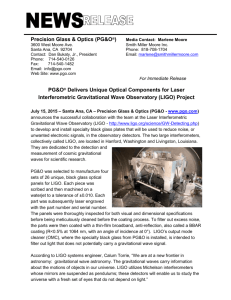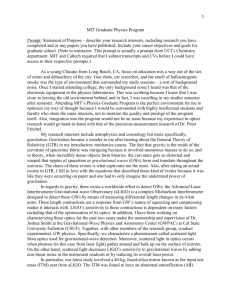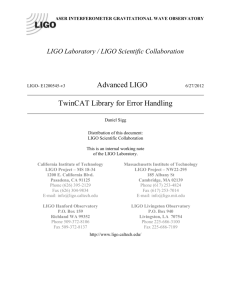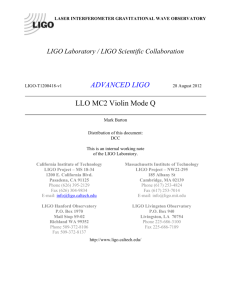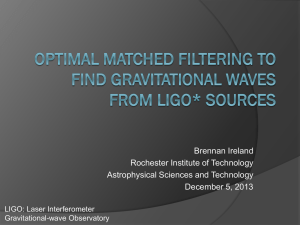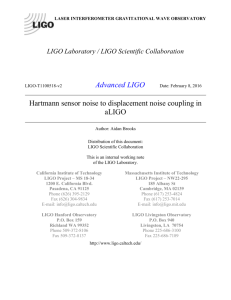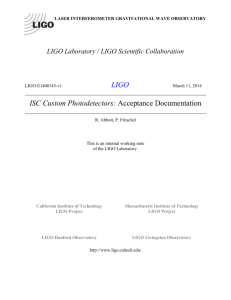LIGO and the MIT Kavli Institute illustrated
advertisement
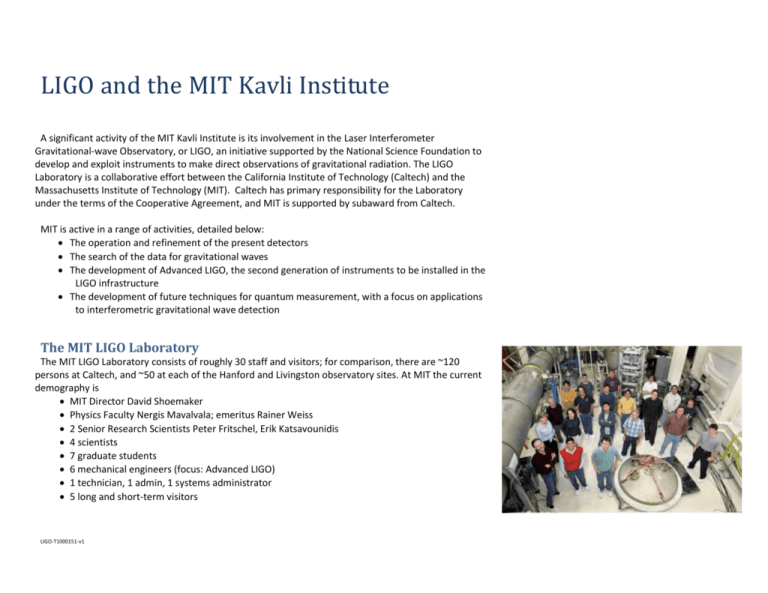
LIGO and the MIT Kavli Institute A significant activity of the MIT Kavli Institute is its involvement in the Laser Interferometer Gravitational-wave Observatory, or LIGO, an initiative supported by the National Science Foundation to develop and exploit instruments to make direct observations of gravitational radiation. The LIGO Laboratory is a collaborative effort between the California Institute of Technology (Caltech) and the Massachusetts Institute of Technology (MIT). Caltech has primary responsibility for the Laboratory under the terms of the Cooperative Agreement, and MIT is supported by subaward from Caltech. MIT is active in a range of activities, detailed below: The operation and refinement of the present detectors The search of the data for gravitational waves The development of Advanced LIGO, the second generation of instruments to be installed in the LIGO infrastructure The development of future techniques for quantum measurement, with a focus on applications to interferometric gravitational wave detection The MIT LIGO Laboratory The MIT LIGO Laboratory consists of roughly 30 staff and visitors; for comparison, there are ~120 persons at Caltech, and ~50 at each of the Hanford and Livingston observatory sites. At MIT the current demography is MIT Director David Shoemaker Physics Faculty Nergis Mavalvala; emeritus Rainer Weiss 2 Senior Research Scientists Peter Fritschel, Erik Katsavounidis 4 scientists 7 graduate students 6 mechanical engineers (focus: Advanced LIGO) 1 technician, 1 admin, 1 systems administrator 5 long and short-term visitors LIGO-T1000151-v1 The MIT LIGO Lab is supported by LIGO Operations (~$2.8M in 2010), Advanced LIGO (~$1.5M in 2010), and a separate grant for Mavalvala on precision measurement (~$200k in 2010). The LIGO Operations funds are in accordance with a 5-year cooperative agreement with the NSF, to be renewed in 2014; Advanced LIGO is a $205M MREFC to end in 2015. MIT and Caltech LIGO Leadership dynamically allocates the LIGO funding between the sites, including MIT, as needs indicate. The MIT LIGO Lab has its laboratory spaces in MIT NW-17, and offices next door in MIT NW-22, about a 10 minute walk from the MKI main building. The Lab spaces include a high bay with a unique full-scale vacuum system prototype (LASTI) used for development and test of LIGO ‘payloads’, as well as laser labs, electronics and mechanical shops, and other laboratory spaces. The current LIGO detectors The LIGO detectors use laser interferometry to measure the distortions of space-time between free masses to directly detect passing gravitational waves. The original idea for interferometric gravitational wave detectors was independently conceived by several scientists, but Prof. Rainer Weiss of MIT was the one among those to bring the idea to fruition. The group at MIT under Weiss’ leadership was instrumental in developing the concept, proposing it to the NSF, and supplying solutions to many of the initial challenges. Weiss was also the first leader of the LIGO Scientific Collaboration, and remains very active in the field. General relativity describes gravity as a manifestation of the curvature of space-time. LIGO will test this description for rapidly changing, dynamical gravity. Indirect evidence of gravitational waves as described by Einstein’s theory of general relativity has been observed in the binary neutron star system PSR 1913+16, discovered in 1974 by Russell Hulse and Joe Taylor. A direct measurement with LIGO will give a direct verification of general relativity's prediction that gravitational waves exist and confirm the spin, velocity, and interaction with mass. More importantly, it can offer a new astronomical window on the universe. The objective of LIGO is to open the field of gravitational-wave astrophysics. Scientists, engineers, staff, and students at Caltech, MIT, and the two observatory sites in Livingston, Louisiana and Hanford, Washington, are operating and improving the LIGO detectors. The sites provide space and infrastructure support for the eventual development of the facility to an advanced detector configuration. The LIGO Scientific Collaboration, some 750 scientists at some 50 institutions, is involved in many aspects of the LIGO-T1000151-v1 instrument science and the astrophysics. We work closely and share data with the French-Italian Virgo Collaboration which operates a 3km armlength instrument near Pisa, Italy. LIGO consists of a four-kilometer and a two-kilometer interferometer at the Hanford Observatory, and a single four-kilometer interferometer at the Livingston Observatory. Each laser interferometer consists of highly stabilized lasers, in-vacuo suspended optics supported by sophisticated vibration-isolation systems and extensive optical systems, inside and outside the vacuum system, which process the light into electrical signals proportional to the gravitational wave strain amplitude. The initial detectors performed better than the original design, and a further improved sensitivity has been recently achieved through minor upgrades. The Livingston Observatory also operates the LIGO Science Education Center, collocated with the Observatory. The Center features about 50 interactive exhibits designed to encourage inquiry-based learning of physical science concepts related to LIGO. LIGO Astrophysics The initial LIGO instruments have made extended observations of gravitational wave strain at an astrophysically interesting level of sensitivity. No gravitational-wave signals have been identified to date in the data; further analysis of existing data may reveal a signal, and observations will continue with the present generation of instruments until October 2010. The analyses to date have yielded several interesting results in the form of new upper limits and significant non-detections. Some of those are as follows: Progenitor scenarios for short gamma-ray bursts (short GRBs) include coalescence of two neutron stars or a neutron star and black hole, which would necessarily be accompanied by the emission of strong gravitational waves. A search was made in temporal and directional coincidence with 22 GRBs that had sufficient gravitational-wave data available in multiple instruments during LIGO's fifth science run, S5, and Virgo's first science run, VSR1. We find no statistically significant gravitational-wave candidates within a (-5, +1) s window around the trigger time of any GRB. We excluded neutron star-black hole progenitors to a median 90% CL exclusion distance of 6.7 Mpc. We undertook a search for gravitational waves from 116 known millisecond and young pulsars using data from the fifth science run of the LIGO detectors. For this search ephemerides overlapping the run period were obtained for all pulsars using radio and X-ray observations. LIGO-T1000151-v1 We report no signal detection from any of the targets and therefore interpret our results as upper limits on the gravitational wave signal strength. We determined updated limits on gravitational radiation from the Crab pulsar, where the measured limit is now a factor of seven below the spin-down limit. This limits the power radiated via gravitational waves to be less than ~2% of the available spin-down power. A stochastic background of gravitational waves is expected to arise from a superposition of a large number of unresolved gravitational-wave sources of astrophysical and cosmological origin. We determined direct limits on the amplitude of the stochastic gravitational-wave background using the data from a two-year science run of LIGO. Our result constrains the energy density of the stochastic gravitational-wave background normalized by the critical energy density of the universe, in the frequency band around 100 Hz, to be less than 6.9 x 10-6 at 95% confidence. The data rule out models of early universe evolution with relatively large equation-of-state parameter, as well as cosmic (super)string models with relatively small string tension that are favored in some string theory models. This search for the stochastic background improves upon the indirect limits from the Big Bang Nucleosynthesis and cosmic microwave background at 100 Hz. We analyzed the available LIGO data coincident with GRB 070201, a short duration hard spectrum gamma-ray burst whose electromagnetically determined sky position is coincident with the spiral arms of the Andromeda galaxy (M31). Possible progenitors of such short hard GRBs include mergers of neutron stars or a neutron star and black hole, or soft gamma-ray repeater (SGR) flares. These events can be accompanied by gravitational-wave emission. No plausible gravitational wave candidates were found within a 180 second window around the time of GRB 070201. This result implies that a compact binary progenitor of GRB 070201, with masses in the range 1 Msun < m1 < 3 Msun and 1 Msun < m2 < 40 Msun, located in M31 is excluded at >99% confidence. If GRB 070201 were caused by a binary neutron star merger, we find that D < 3.5 Mpc is excluded, assuming random inclination, at 90% confidence. The result also implies that an unmodeled gravitational wave burst from GRB 070201 most probably emitted less than 4.4 x 10-4 Msun c2 (7.9 x 1050 ergs) in any 100 ms long period within the signal region if the source was in M31 and radiated isotropically at the same frequency as LIGO's peak sensitivity (f ~ 150 Hz). The MIT data analysis group, led by Dr. Erik Katsavounidis, focuses on burst-like sources of gravitational waves, and on the significant effort to identify and remove sources of non-stationarity in the detector noise background. He has led the Burst Search group (one of four search groups in the Collaboration), LIGO-T1000151-v1 and is also a leader in the use of grid computing (for which has held a separate grant). He also has a strong interest in multi-messenger astrophysics, exchanging triggers with GRB, neutrino, and EM observatories to increase the information extracted from LIGO’s signals and to provide temporal search windows for the search process. The MIT group has also been a strong contributor to the search for a stochastic background, having led the group in the early phases of the search, and contributing the notion of a directed ‘radiometer’ search. A different but important role in data analysis is filled by the MIT LIGO instrument science experts in providing a connection between the identification of non-stationary noise sources in the data and explanations in the instrument itself. This both helps to develop effective ‘vetoes’ for these signals which can imitate gravitational wave signals, and also provides guidance for the instrument commissioners to try to reduce or eliminate the instrumental sources of these signals. Advanced LIGO The sensitivity of the initial LIGO instruments is such that it is perfectly possible that discoveries will be made. Whether detections are made or not, development of the next generation of instrument must be pursued aggressively to make the transition from the initial to the Advanced detector in a timely way. The Advanced LIGO interferometers currently being fabricated to realize that plan are designed to give an improvement over initial LIGO in sensitivity by more than a factor of 10 over the entire initial LIGO frequency band. It also increases the bandwidth of the instrument to lower frequencies (from ~40 Hz to ~10 Hz) and allows high-frequency operation due to its tunability. This translates into an enhanced physics reach that during its first several hours of operation will exceed the integrated observations of the 1 year initial LIGO Science Run. These improvements will enable the next generation of interferometers to study sources not accessible to initial LIGO, and to extract detailed astrophysical information. For example, the Advanced LIGO detectors will be able to see inspiraling binaries made up of two 1.4 M neutron stars to a distance of 200 Mpc, some 15x further than the initial LIGO, and giving a most likely event rate of 40/year -- roughly one a week. Neutron star - black hole (BH) binaries will be visible to 650 Mpc; and coalescing BH+BH systems will be visible to cosmological distance, to z=0.4. The basic optical configuration is a power-recycled and signal-recycled Michelson interferometer with Fabry-Perot "transducers" in the arms. Using the initial LIGO design as a point of departure, this requires the addition of a signal-recycling mirror at the output "dark" port, and changes in the interferometer LIGO-T1000151-v1 readout and control systems. This additional mirror allows a tailoring of the interferometer response according to the character of a source (or specific frequency in the case of a fixed-frequency source). The upgrade includes the three LIGO interferometers, with a reuse of the vacuum, technical, and human infrastructure at the observatories. To improve the quantum-limited sensitivity, the laser power is increased from the initial LIGO value of 10 W to ~200 W. Whereas initial LIGO uses 25-cm, 11-kg, fused-silica test masses, the fused silica test mass optics for Advanced LIGO are larger in diameter (~34 cm) to reduce thermal noise contributions and more massive (~40 kg) to keep the radiation pressure noise to a level comparable to the suspension thermal noise. The test mass is suspended by fused silica fibers, in contrast to the steel wire sling suspensions used in initial LIGO. The resulting suspension thermal noise is anticipated to be less than the radiation pressure noise (in broad-band observation mode) and to be comparable to the Newtonian background ("gravity gradient" noise) at 10 Hz. The seismic isolation system serves to bring the seismic cutoff frequency from 40 Hz (for initial LIGO) to 10 Hz. RMS motions (frequencies less than 10 Hz) are reduced by active servo techniques. The result is to render the seismic noise negligible at all observing frequencies. The overall performance of Advanced LIGO is dominated at most frequencies by the quantum noise of sensing the position of the test masses, with a contribution at mid-frequencies from the internal thermal noise of the test masses. The NSF-funded MREFC Advanced LIGO Project started in April 2008, and as of February of 2010 it is 23% complete (earned value), compared to 24% planned. The cost variance is positive (in part due to flux in the economy since the cost baseline was established), and the contingency is currently 28% of the estimate to complete. The detailed design is ~90% complete, and many subsystems are now in fabrication and assembly. The Laboratory currently working on the Project in parallel with observation; when the initial LIGO science runs are complete in October 2010, the Project will take over the observatories and commence decommissioning of the initial instruments. The first interferometer is planned to be accepted in early 2014, and if all goes well a first science run at an intermediate sensitivity could take place as early as 2015. The MIT LIGO Laboratory is deeply involved in Advanced LIGO. The Project Leader and co-PI is David Shoemaker; the System Scientist is Peter Fritschel; and two of the core subsystems (Interferometer Sensing and Control, and the Seismic Isolation) are led by MIT LIGO Staff. The MIT LASTI prototype is the only place where full-size seismic isolation, suspension, and other elements of Advanced LIGO can be LIGO-T1000151-v1 tested in situ, and MIT has thus become a focus for a number of the other subsystems in the development and test phase. Quantum Measurement Next-generation interferometers are expected to be limited by quantum optical noise at almost all frequencies. This noise arises from the discrete nature of light (photons) and the quantum fluctuations of the electromagnetic field. One aspect of the quantum limit, the shot noise, arises from the quantum fluctuations in the number of photons detected at the interferometer output. Injection of squeezed vacuum into the output port of the interferometer can be used to improve the sensitivity and/or reduce the power circulating the interferometer for a given target sensitivity. Consequently, we have developed techniques for generating squeezed vacuum states that can be used to improve the quantum-noiselimited performance of gravitational wave detectors, and are currently building a squeezed state source using optical parametric processes in nonlinear crystals for installation in the 4km detector at Hanford. While this approach is not yet part of the Advanced LIGO baseline, it is under consideration for either a late incorporation in the initial instrument or as an early ‘upgrade’. The other aspect of the quantum limit, arising from the radiation pressure that the quantum fluctuations of the laser light exerts on the (movable) mirrors, can be exploited for variety of applications that extend beyond GW detection. The optical mode that is used to measure the mirror position can also be dynamically coupled to the motional mode of the mirror. This light-mirror coupling can modify the dynamics of the mirror oscillator, and can be used to optically cool and trap the mirror. Analogous to laser cooling and trapping of atoms, we have developed a laser cooling and trapping technique for mirrors. This technique is expected to be an essential tool in the quest for ultimately reaching the quantum limit and studying quantum behavior of very large, life-size objects - macroscopic mirrors. In two separate experimental settings, we are now applying mirror trapping to approach the quantum regime in gram-scale mirrors and in nanogram-scale cantilevers. This group, under the direction of Prof. Nergis Mavalvala, is a very nice point of interface with students who then often broaden their interests into the field of gravitational wave detection. The NSF funds Prof. Mavalvala for this activity separately from the LIGO Laboratory, but the activities take place in the context and infrastructure of the Lab and with Lab support. LIGO-T1000151-v1

